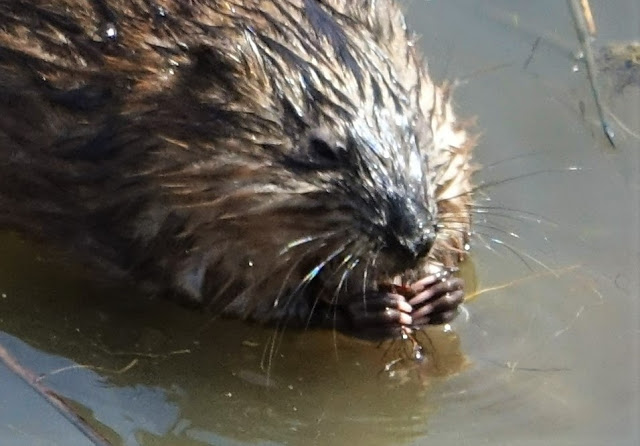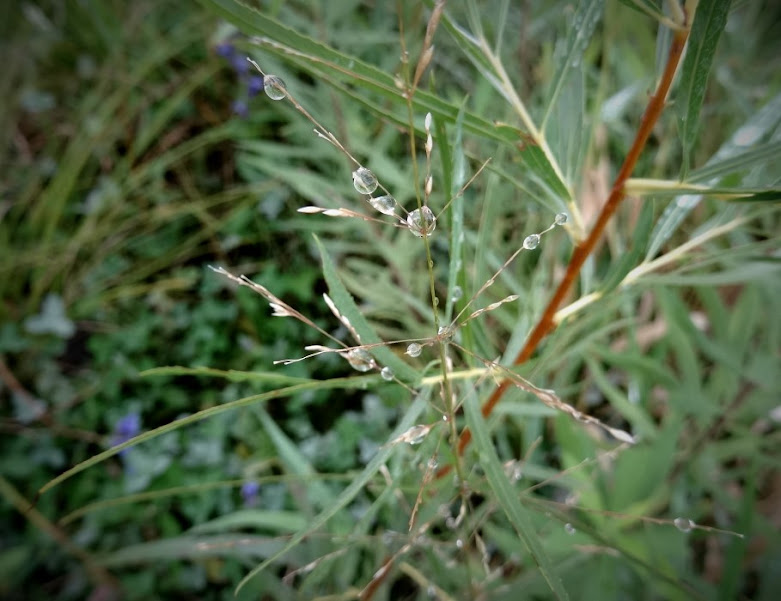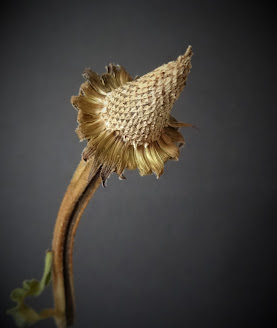6/22/2023
two killdeers
6/10/2023
floating log
4/12/2023
muskrat claws
The muskrats Ondatra zibethicus who live on the pond are semi-aquatic rodents.
They eat mostly plant matter, but also smaller critters that they find. To eat, they have a thumb and four fingers -- with claws -- to grasp food. The back feet are larger and have five webbed fingers that help swimming in ponds, lakes, and rivers. They swim under water hunting for vegetation that they gnaw and chew with large incisor teeth located in front of their cheek. Or, they may sit on shore chewing terrestrial grasses.
9/06/2022
vivipary = seed heads sprouting
This wildflower was finished blooming and was forming seeds. But its seed head sprouted green leaves! Fascinated, I looked closer. Some of new seeds were actually germinating and sprouting while still in the seed head. Usually, they wait until they are in the perfect place (soil, moisture, temperature, sunlight) to begin new growth. Sometimes you see this while seeds are still inside the fruit, like a tomato or green pepper. In plants, it is called vivipary (Latin for 'live birth') and involves seeds germinating before their determined time. I first learned about this a few years ago when my grandson sent me a photo of a sunflower seed head that was doing the same thing.
9/05/2022
scouring rush 'horsetail'
Scouring Rush Equisetum hyemale grows in the wetland around the pond.
It is also called 'horsetail'. This plant has coarse fibers and silica deposits in its stems, so herbivores don't eat this plant.
For more about this plant, see blog posts on 7/23/2020 and 6/25/2021.
5/08/2022
muskrat claws
Often we can see a muskrat swimming back and forth in the pond, harvesting plants and taking food home to the family. Muskrats Ondatra zibethica eat the roots, stems, leaves, and fruits of many water plants such as cattail, rushes, smartweed, duck potato, horsetail, sedges, and willow sprouts. They are strong swimmers due to their two long back feet and five webbed toes. For grasping and harvesting food, they have developed smaller front feet with four fingers with claws and a small thumb. By living near the pond, muskrats control plant growth, provide open spaces for new plants to grow, and make space for other animals to build their nests.
1/19/2022
FeederWatch, Downy Woodpecker
FeederWatch, a citizen-science program of Cornell University Lab of Ornithology, is once again an activity for me through the cold winter months. This small Downy Woodpecker Dryobates pubescens comes every day to feed at the suet block hanging near the pond. Suet supplements his regular diet of insects which he searches for between folds of tree bark. His tail feathers are strong and positionable to support him on tree branches or wherever he finds food.
11/08/2021
leaf galls
This fallen leaf has galls all over it, lumps or complicated structures that look like capsules containing something mysterious. Galls are made by one of 1500 species of gall producers -- mostly insects and mites. Some galls form on leaves where insects feed on the plant matter, or lay eggs. Galls may also develop as a response to infections by fungi, bacteria, or viruses. Dissecting the gall is the only sure way to tell what caused it. That's a whole different adventure!
9/26/2021
8/21/2021
blooming water plantain
8/11/2021
hummingbird 2021
The twig hanging over the water is a favorite perch for birds.
This Ruby-throated Hummingbird sits on the twig to rest on her way to the Lonicera blooming nearby.
6/24/2021
galls on goldenrod
6/22/2021
widow skimmer
This dragonfly male 'Widow Skimmer' Libellula luctuosa shows off his handsome transparent wings with black and white structural coloration -- the production of color by microscopically structured surfaces fine enough to interfere with visible light.
The grass seedhead on the left is close to the camera and in front of the wing. But the rush stem behind the wing is showing clearly through the transparent wing while the skimmer rests, clasping that stem.
He is probably looking for prey -- other insects such as mosquitoes. To catch prey he will use his legs, and bring prey into his mouth with fangs.
6/19/2021
mullein
Several Mullein plants are growing in the riparian zone around the pond. The plants are small rosettes of fuzzy leaves, close to the ground, the first year of their growth. The second year, Common Mullein Verbacum thapsus shoots up a stem clad in very fuzzy leaves topped by a flower spike (left).
Once the flower blooms, it is a brilliant torch of yellow blossoms. Each blossom has 5 petals, and stays open for a short time. Thus, the spike may have only a few blossoms open at a time.
4/03/2021
3/24/2021
junco in spring
10/20/2020
slush trail
Snow! Several inches. Before we were ready for it. Before the Mallards were ready for it. As they paddled around on the pond to find breakfast, they made a trail in the accumulating slush on the water.
9/27/2020
muskrat tail
The muskrats who live here were gathering breakfast this morning in the pond. One, with tail held high, munched aquatic plants growing to just below the water surface. Their tails are 7 to 11 inches long, covered in scales rather than fur, and flattened vertically (side-to-side) to serve as a rudder in swimming.
9/12/2020
8/17/2020
Coneflower seed harvest
It is time to harvest some wildflower seeds, in order to expand the native plant population in the riparian buffer surrounding our pond. There are more than 30 documented native species in this buffer. Close to the water is a ring of wetland; outside of that is a ring of moist to dry areas. So the pond provides a comfortable home for a wide variety of plants. We hope to reduce the 'weeds' and encourage the flowering native plants to flourish.
For example, a few coneflowers bloom here. Purple Coneflower Echinacea purpurea now has some blooms 'going to seed' as the petals dry out. When I remove the seeds, intending to spread them around the pond for new plants, we can see why this plant is called 'cone flower'.




























